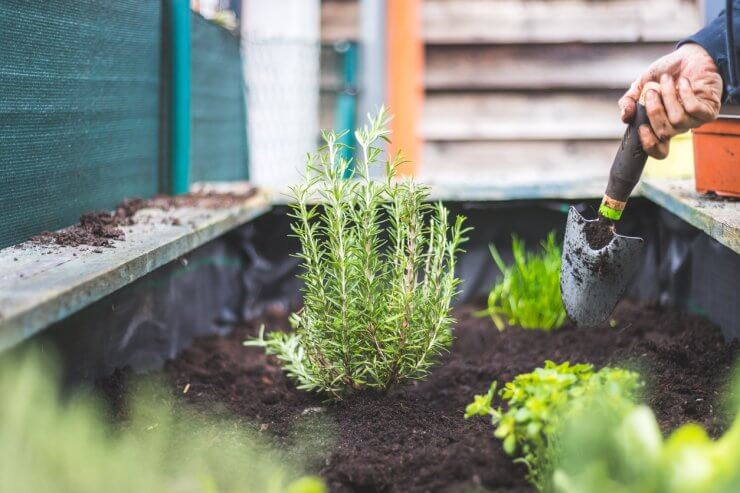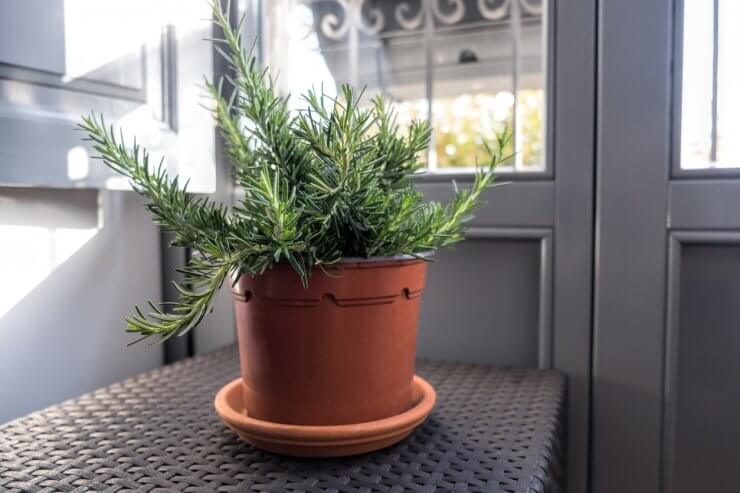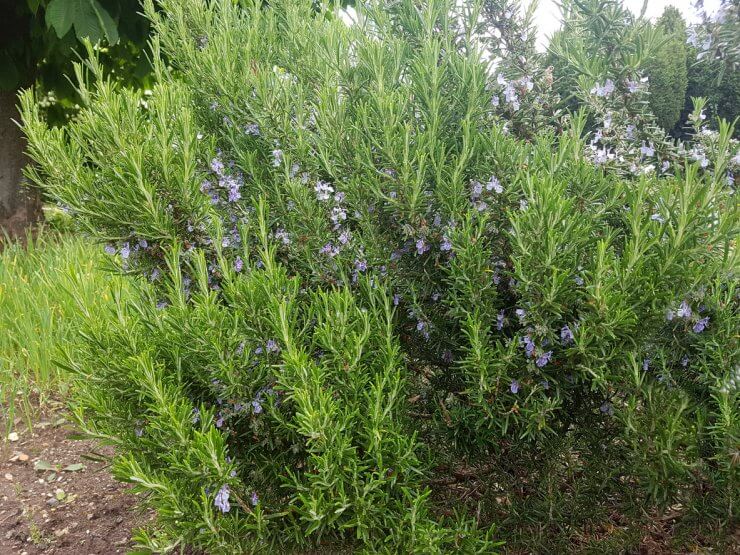
Planting rosemary in large planter box
Wherever you choose to grow rosemary, in open land, a raised bed, or a pot, general care is simple! Rosemary prefers dry feet and needs well-drained, sandy or loamy soil, plus six to eight hours of sunlight. As for acidity, rosemary grows best in slightly acidic soil with a pH between 6.0 and 7.0. It likes warm temperatures with moderate humidity and can grow into a shrub several feet tall.
In fact, it can grow so vigorously in the right conditions that it can become a bit out of control if not managed properly.
Growing Rosemary in Containers or Pots

Rosemary grown in a pot
Because rosemary cannot stand up to winters below 30 degrees F, many people outside zones 7 to 10 prefer to grow it in pots that can be brought inside for the winter. (Rosemary does not transplant well from the ground to a pot, so if you want fresh rosemary in the winter and plan to grow it in a raised bed or open ground as an annual, plant a separate one in a pot to begin with.)
You also may not have the space for growing in open land or in raised beds, so you can grow rosemary in containers or pots indoors or on your balcony, porch, patio, or deck.
Outdoor pots can be moved to give your rosemary access to the full six to eight hours of sun. If you want to grow rosemary indoors, you’ll need a south-facing window that gets the full amount of sun.
Choose terracotta pots for rosemary, because terracotta allows the plant to dry out faster and, as noted, rosemary likes dry feet. Just water your potted rosemary when the soil is dry to the touch.
Remember, containers can lose important soil nutrients throughout the season, so you might need additional fertilizer. Also, rosemary is likely to become root bound—keep an eye out for yellowing of the lower foliage as a clue—so it should be repotted at least once a year.
Growing in Raised Beds
Raised beds are a great option for an herb garden if you have perpetually wet, heavy soil. Creating raised beds for your garden can be a lot of work the first time you set up your beds, but having raised beds allows you more control over your growing environment. You’ll discover that watering, weeding, and even harvesting are much easier, with items closer to your reach and contained in a space that is more manageable than growing in open land.
To create nicely contained raised beds for your rosemary and other herbs, enclose your raised beds with wooden sides 8 to 12 inches high and 3 to 4 feet wide—this will give the plants’ roots room for spreading.
A raised bed garden is less likely to contain the seeds of weeds that are often found in garden soil. You’ll minimize the incidence of weeds overall, which will save you time and effort later.
Weeding itself is much easier with raised beds, because you don’t have to get down so far on the ground to remove weeds.
Tip: Be sure to amend your soil with compost at least once a year. Otherwise, your soil can become less productive for your plants.
Growing in open land

Rosemary in open land
For open land growing, you’ll need to choose a spot with the full sun that rosemary requires. You might also choose to plant it with common companion herbs, such as thyme, oregano, sage, and lavender, or near beans, cabbage, carrots, and sage. (Rosemary deters bugs that snack on these plants, as well as being resistant to wildlife such as deer and rabbits.)
Next, you must prepare the soil properly. Start by removing all rocks, weeds, tree roots, and other plant debris from your chosen site.
For best growth, the soil temperature should be around 70 degrees F.
You should always collect a soil sample and have it analyzed by your local County Extension Service to determine your soil’s fertility level. Then, as needed, add compost or organic matter to supplement the soil’s nutrition level.
Use 1/3 of this compost or organic matter and 1/3 sand or fine grit to improve drainage.
It’s OK if you don’t make your own compost—you can buy bulk compost from most gardening supply stores. Try to find “certified compost” with the U.S. Composting Council’s Seal of Testing Assurance (STA)—their rigorous testing process and standards will ensure you get quality compost.
If you have highly acidic soil, you’ll want to add lime, as rosemary grows best in soil with a pH of about 6.0 to 7.0. With your compost and amendments on top of your soil, use a spade fork to turn the soil over and mix everything together.
Remember, soil health is one of the most important things to ensuring that your rosemary plants thrive.
Dig a hole in your chosen site as deep as the root ball and twice as wide. Set the plants in place and backfill, gently firming the soil over the roots.
Wherever you grow them, you should prune rosemary plants to make them bushier and keep them under control. Just snip sprigs off, making sure that blooming has ended first. A good rule of thumb is not to take more than a third of the plant at any time, and make your cuts just above a leaf joint.
Don’t prune in the late autumn or winter when this tender perennial is hardening off to survive cold winter temperatures.
Pruned sprigs can be used in cooking right away, or saved by drying upside down in bundles in a cool, dry place.
How do you grow your rosemary—in open land, in raised beds, or in containers? Why do you prefer your method? Please tell us your tips and tricks for creating a bountiful rosemary garden.


 Previous
Previous


You mention growing Rosemary outside in beds or open land but also that Rosemary can’t stand temperatures below 30 degrees. I live in Zone 8a but we will have a few temperatures below 30 degrees every winter. Would Rosemary need to be protected outside if the temperature got below 30 degrees?